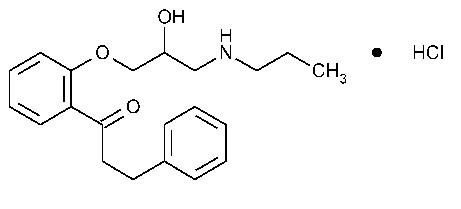Propafenone Hydrochloride
1-Propanone,1-[2-[2-hydroxy-3-(propylamino)propoxy]phenyl]-3-phenyl-,hydrochloride.
2¢-[2-Hydroxy-3-(propylamino)propoxy]-3-phenylpropiophenone hydrochloride [34183-22-7].
»Propafenone Hydrochloride contains not less than 98.0percent and not more than 102.0percent of C21H27NO3·HCl,calculated on the dried basis.
Packaging and storage—
Preserve in tight,light-resistant containers,and store at a temperature between 15 and 30
and 30 .
.
Clarity of solution—
Dissolve 1.0g in 30mLof hot water,and observe without delay:the solution initially is clear.
Identification—
A:Infrared Absorption á197Kñ.
B:
Dissolve 0.5g of propafenone hydrochloride in 50mLof water with heating.Adjust with 0.1Nsodium hydroxide to a pHof 9.5to 10.0:a precipitate is formed.Cool the mixture,and filter.Add 1mLof 6Nnitric acid and 2to 3drops of 0.1Nsilver nitrate to the filtrate:a precipitate is formed,which dissolves upon the addition of a few drops of ammonium hydroxide.
pHá791ñ:
between 5.0and 6.2in a solution (1in 200).
Loss on drying á731ñ—
Dry it at 105 to constant weight;it loses not more than 0.5%of its weight.
to constant weight;it loses not more than 0.5%of its weight.
Residue on ignition á281ñ:
not more than 0.1%.
Heavy metals,Method IIá231ñ:
20ppm.
Limit of methanol and acetone—
Proceed as directed for Test Preparationand Chromatographic Systemin Method Vunder Organic Volatile Impurities á467ñ.
Standard preparation—
Prepare a solution,in dimethyl sulfoxide,containing 2.0µg of methanol and 20.0µg of acetone.
Procedure—
Separately inject equal volumes (about 1µL)of the Standard preparationand the Test preparationinto the chromatograph,record the chromatograms,and measure the peak responses.Identify,based on retention time,any peaks present in the chromatogram of the Test preparation,and calculate the amounts of methanol and acetone present.Not more than 100ppm of methanol and 1000ppm of acetone are found.
Chromatographic purity—
Mobile phase—
Prepare a filtered and degassed mixture of 2.5mMtetrabutylammonium hydrogen sulfate and acetonitrile (16:9).Make adjustments if necessary (see System Suitabilityunder Chromatography á621ñ).
Diluent—
Prepare a mixture of acetonitrile and water (9:1).
Standard solution—
Dissolve an accurately weighed quantity of USP Propafenone RSin Diluent,and dilute quantitatively,and stepwise if necessary,with Diluentto obtain a solution having a known concentration of about 5µg per mL.
Test solution—
Transfer about 50mg of Propafenone Hydrochloride,accurately weighed,to a 50-mLvolumetric flask,dissolve in 5mLof Diluent,dilute with Mobile phaseto volume,and mix.
Chromatographic system (see Chromatography á621ñ)—
The liquid chromatograph is equipped with a 222-nm detector and a 3.9-mm ×15-cm column that contains packing L10.The flow rate is about 1.0mLper minute.Chromatograph the Standard solution,and record the peak responses as directed for Procedure:the column efficiency is not less than 2000theoretical plates;and the relative standard deviation for replicate injections is not more than 15%.
Procedure—
Separately inject a volume (about 10µL)of the Standard solutionand the Test solutioninto the chromatograph,and allow the Test solutionto elute for not less than eight times the retention time of propafenone.Record the chromatogram,and measure the peak responses for all the peaks:the sum of the peak responses,other than that of propafenone,in the chromatogram of the Test solutionis not more than two times the propafenone response obtained from the Standard solution(1.0%);and no other peak response,other than that of propafenone,in the chromatogram of the Test solutionis greater than the propafenone response obtained from the Standard solution(0.5%).
Assay—
Transfer about 250mg of Propafenone Hydrochloride,accurately weighed,to a 125-mLflask.Dissolve in 30mLof methanol,add 15mLof mercuric acetate TS,and titrate with 0.1Nperchloric acid VS,determining the endpoint potentiometrically.Perform a blank determination,and make any necessary correction.Each mLof 0.1Nperchloric acid is equivalent to 37.79mg of C21H27NO3·HCl.
Auxiliary Information—
Staff Liaison:Andrzej Wilk,Ph.D.,Senior Scientific Associate
Expert Committee:(PA5)Pharmaceutical Analysis 5
USP28–NF23Page 1644
Pharmacopeial Forum:Volume No.29(3)Page 659
Phone Number:1-301-816-8305
